No, Politicians Shouldn’t Outlaw Driving to Usher in Self-Driving Cars

Over at Fusion, Kevin Roose has what is perhaps the worst article on automated vehicles (AVs) I’ve ever seen. In it, he calls for a near-term phase-in of a blanket national driving ban—specifically, beginning it in 2017 and completing it in 2020. That’s quite an ambitious “phase-in,” given that the average age within the U.S. car and light-truck fleet is more than 11 years.
This call to action isn’t based on facts about where the technology is today or what we can reasonably expect it to offer consumers over the next decade (or even that pesky thing called “the law”); rather, it assumes that fully automated, self-driving highway vehicles are essentially already here while providing no evidence that they’re near the deployment stage. That’s because they’re not.
To be clear, automation is already here. But automation is a spectrum, with technologies such as adaptive cruise control on one end and autonomous taxis on the other. Here’s how the National Highway Traffic Safety Administration currently defines the various levels of automation:
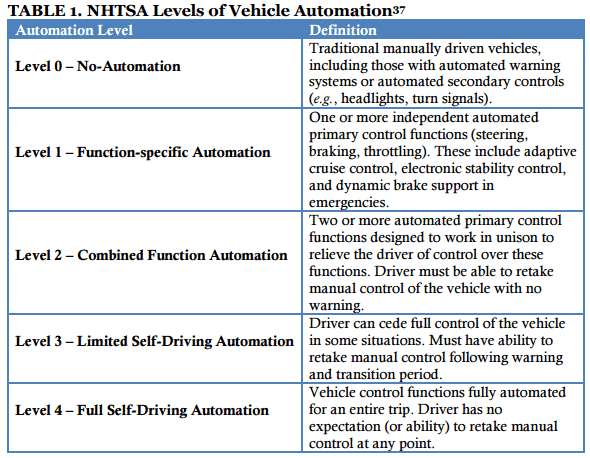
And here’s how SAE defines them:
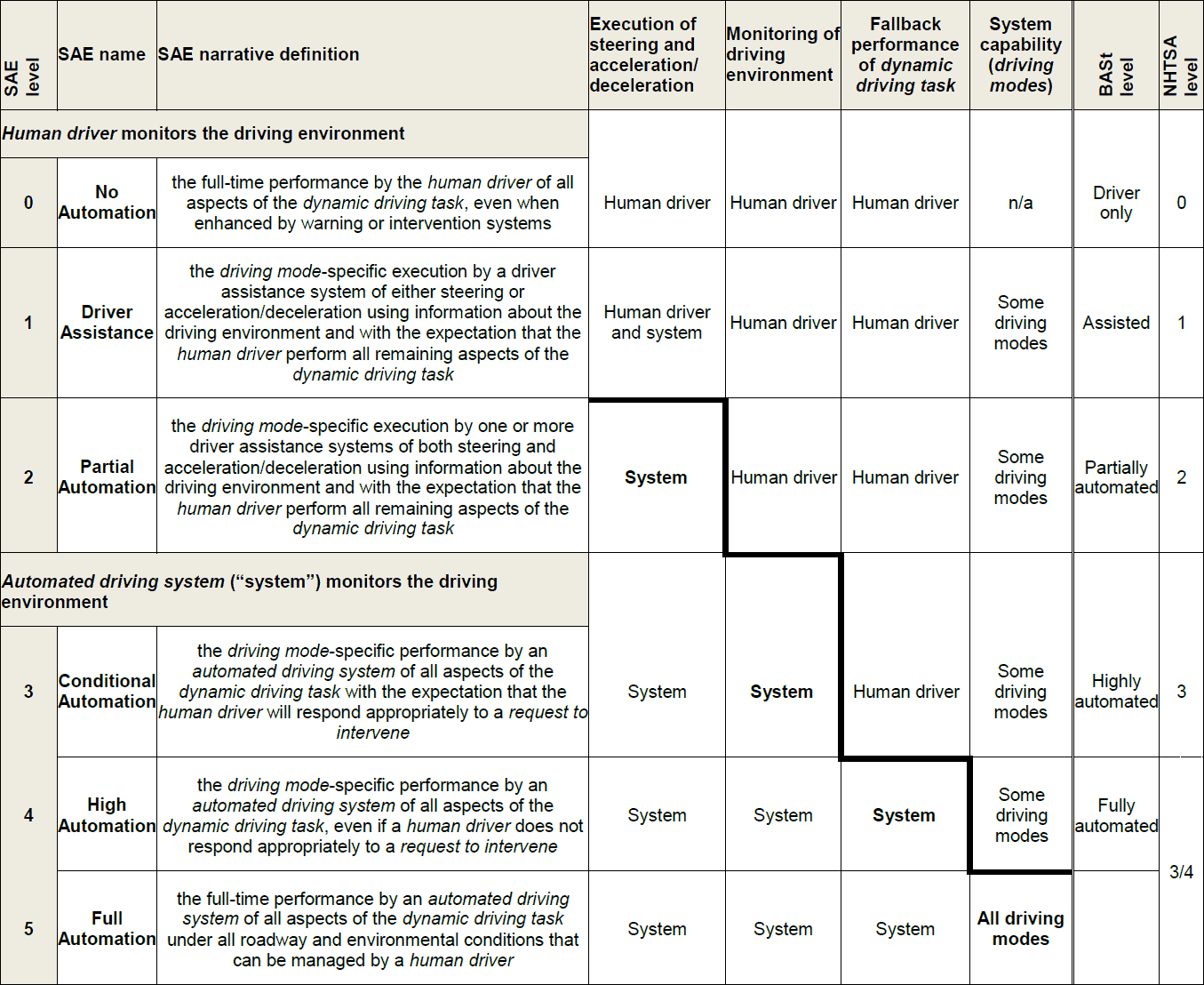
Note that these levels are not without criticism, but they’ll be useful in keeping our definitions straight. In his piece, Roose is referring solely to NHTSA Level 4 and SAE Level 5 vehicles. This is well beyond the NHTSA and SAE Level 1 vehicles you can purchase right now with features such as adaptive cruise control. So, when do people who spend their careers working on this technology and related issues believe that NHTSA Level 4/SAE Level 5 vehicles will be available to consumers?
Back in 2014, attendees (including myself) of the Transportation Research Board’s annual Automated Vehicle Symposium were surveyed on their predictions for the consumer availability of a variety of automation technologies. On the question of when they expect consumers to be able to access vehicles where the operator has no responsibility or perhaps even no ability to manually direct the vehicle at any point (NHTSA Level 4/SAE Level 5), the median response was 2030 for both all attendees and experts with advanced technical degrees:

But when it comes to the future imagined by Roose, where all driving is outlawed and driver licensing is abolished, the experts were significantly less optimistic:

In attempt to defuse Luddite claims against my personal motivations, I will admit that much of my time for the past five years has been spent working on AVs (as in, more than a third of my time for the past five years). I’m a strong supporter and still view legal and policy issues as the most significant hurdles facing AVs. This is not to say that technical hurdles are minor, only that AV political and legal concerns are likely to raise a whole host of eyebrows in the future.
However, given the complexity and novelty of self-driving systems, the engineering testing and validation process required before consumer release is far more difficult than anything we have seen before, as Bosch’s Jan Becker highlights here. In a recent presentation on how federal safety regulators are preparing for increasing levels of automation, the National Highway Traffic Safety Administration’s Frank Barickman concluded with the following slide:
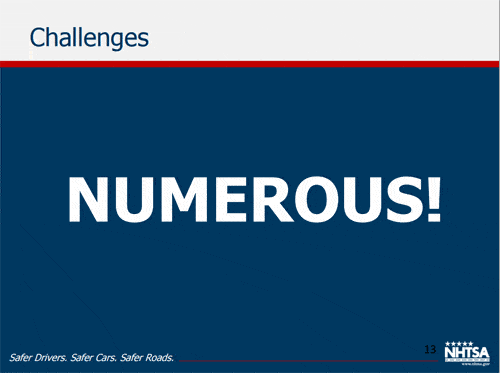
Now, these are the experts expressing views in stark contrast with Roose’s. What does the public think about automated vehicles? Brandon Schoettle and Michael Sivak of the University of Michigan’s Transportation Research Institute polled members of the public in the U.S., U.K., and Australia on their perceptions of automated vehicles with varying automation levels. In all countries, more than half of the public was very or moderately concerned about riding in the NHTSA Level 4 self-driving vehicles Roose supports mandating:
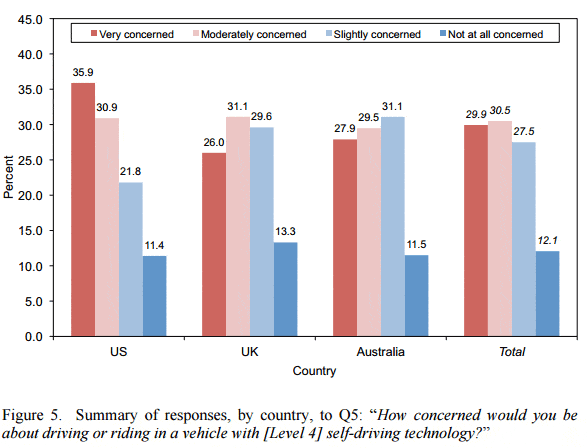
Not only does the public still need to be convinced of the safety, productivity, and other benefits, they also have little willingness to pay more for the technology:
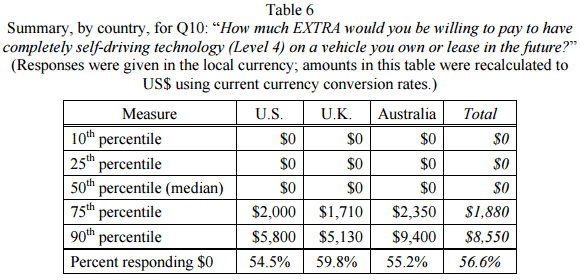
The notion that we can just legislate vehicle automation technology into existence and 100 percent deployment, and at a price point that wouldn’t severely disrupt economic activity and everyday life, is completely nonsensical. In fact, both developers and regulators have opted to take a wait-and-see approach, allowing the technology to naturally evolve and to respond to meet challenges as they present themselves.
Attempting to ram self-driving cars down the throats of consumers is exactly opposite to the approach supported by researchers, developers, and regulators. They know that the public must be convinced that road vehicle automation provides them private benefits in order for them to start adopting AVs, especially those vehicles with higher levels of automation.
The good news is that Roose is unlikely to be taken seriously by anyone who knows what they’re talking about or is in a position of power. The bad news is that authoritarian threats to ban cars will make developing a value proposition the public will accept all the more difficult, which could delay the eventual fleet conversion into fully automated vehicles—which I guess would mean Roose and his AV-mandate compatriots would have blood on their hands?
For more on public policy and automated vehicles, see my 2014 white paper here.